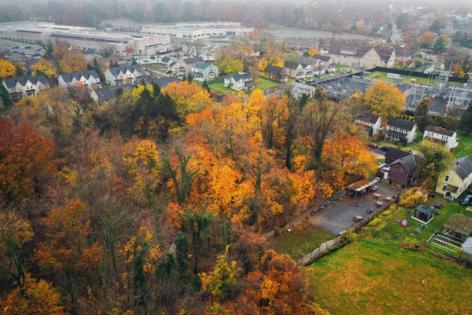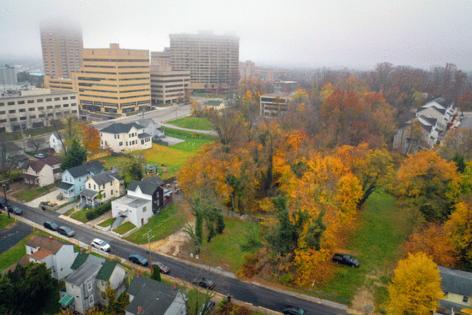Will Baltimore County meet its 2027 housing mandate? County, civic leaders are split.
Published in News & Features
BALTIMORE — In June 2022, Angela Coleman filed an application with the Baltimore County Department of Housing and Community Development. The Owings Mills nonprofit executive wanted financial help building 22 apartment units after buying a single-acre property on Eastern Avenue near Beasley Lane in Bengies-Chase, a historically Black village in Middle River.
Those units likely would have counted toward a looming deadline Baltimore County must meet in 2027. Per a 2016 agreement reached with three county residents, a now-defunct nonprofit, and the local NAACP chapter, the county must create 1,000 affordable housing units to resolve a 2011 federal housing complaint that accused the county of adopting racist housing policies.
Baltimore County Executive Johnny Olszewski Jr. is confident the county will reach that goal, but others, like NAACP First Vice President Roland Patterson Jr., are skeptical, citing community resistance to similar, albeit larger, developments.
Coleman’s organization, Sisterhood Agenda, wanted to build housing for women experiencing trauma, with units set aside for people making up to 60% of the area’s median household income. Whereas a typical developer would have built the maximum amount, Coleman said she wanted to create spaced-out, “eco-friendly, safe, climate-resilient” housing while preserving 90% of the property.
In a federal housing complaint she filed earlier this year, she accused Baltimore County Councilman David Marks of targeting her business in a “personal vendetta” over zoning and violating “fair housing rights for us and Baltimore County residents during a housing crisis,” according to the complaint and a letter to Olszewski.
She also sued a neighbor who criticized the project for defamation, seeking $225,000, according to court records. The Baltimore Banner first reported the U.S. Department of Housing and Urban Development’s investigation into Coleman’s complaint. Marks disputed Coleman’s assertions, and said he was trying to preserve green space for one of Baltimore County’s oldest Black areas.
That 1,000-unit agreement came after the local NAACP chapter and now-closed Baltimore Neighborhoods Inc. nonprofit complained that the county’s housing policies perpetuated segregation by concentrating low-income housing in poorer neighborhoods and demolishing 4,100 subsidized housing units without replacing them.
By the end of this year, Baltimore County is on track to approve 979 units, with 865 slated for construction, according to Olszewski and County Housing and Community Development Director Terry Hickey. Both are optimistic the county will reach its goal by 2027 of creating the units, which must be affordable to households making below 100% of the area median income. In recent years, the county created a housing agency, strengthened oversight of vacant homes, and struck a deal with Harborplace developer P. David Bramble to set aside some units for affordable housing in exchange for tax breaks.
Olszewski said his administration recognizes that new developments often take years to build and permit. He encouraged his officials to fix existing units and look for ways to preserve existing units, with an eye on achieving what he calls “attainable housing,” aimed at middle-income people who make too much to qualify for subsidized housing but too little to buy or rent without assistance. Baltimore County’s area median household income is $122,200.
“Affordability is important. There’s a certain stigma attached to [affordable housing], and we’re not always thinking about the important parts,” he said. “We want high-quality construction but we also want it to be near business and transit. We want to look at, what does this project do to uplift surrounding communities?”
Maryland Housing Secretary Jake Day is also optimistic, noting that the political terrain has changed since 2016. Politicians across the U.S. are now openly pro-housing, recognizing the nationwide housing shortage. A third of Maryland’s 96,000-unit shortage is concentrated in the Baltimore region, spurring the passage of a statewide law that will allow some developments to bypass obstacles at the local level when it takes effect in January. The legislation requires local governments to allow denser developments if they meet certain standards, such as being located within 0.75 of a mile of a public transit hub.
“People in positions of trust now recognize that families are getting crushed [by housing costs],” Day said. “We can get out of here by building [more] housing.”
Patterson is skeptical that excitement will extend to Baltimore County, whose council maintains strict control over land use and zoning.
“I hope they prove me wrong,” he said in an interview. “But there’s a mindset of resistance towards affordable housing.”
He pointed to resistance against Sisterhood Agenda and the hurdles another affordable complex, Red Maple Place, has faced. Annapolis developer Homes For America has been trying to build 56 affordable units on a 2-acre East Joppa Road property since 2017, but only recently declared victory after years of legal challenges preventing its construction.
Residents near the East Towson project say it would take away green space and further encroach upon the historic neighborhood, which housed descendants of formerly enslaved people and has since been gentrified.
Patterson also pointed out that Olszewski is running for Congress and will not be the county executive in 2027. Not everyone in Towson shares Olszewski’s willingness to make this a priority, he said.
He pointed toward the council’s recent vote during the 2024 comprehensive zoning map process, at Marks’ request, to preserve zoning that disallows more than 5.5 units per acre on the property Coleman wanted to buy.
“There have been various attacks on every phase of the project,” he said. The council has flexed its authority over land use this year, vetoing a piece of legislation Olszewski proposed to create mixed-use development, and overriding his veto of an ordinance that caps building in areas with overcrowded schools.
HUD is investigating Baltimore County for allegedly discriminating against Coleman, a Black woman, on the basis of race and gender, according to a May 1 letter from the agency.
Marks, an Upper Falls Republican, disputed having a vendetta against Coleman, noting the Bengies-Chase community is a historically Black enclave.
“I will not support just handing over parkland, particularly without strong review and support from the surrounding community,” Marks wrote to The Baltimore Sun on Friday. “I stand with those residents and will support protecting public land from development just as I have throughout the Eastside.”
Day said he does not think the most recent state legislation will go far enough to spur more housing production.
“The Baltimore County Council still has incredible local control,” he said. “It’s natural that local officials are highly susceptible to pressures advocating against change. They’re exposed to the loudest voices that say, ‘Don’t do this thing.’”
Marks and Council Chair Izzy Patoka, a Pikesville Democrat, dispute that characterization. Both agree the county has a mandate to create housing, but want to preserve parks and green space, especially in more developed areas like downtown Towson.
Patoka, a former planner, said the answer was to double up on efforts like constructing more schools, redistricting to alleviate overcrowding, and adding more capacity to the county’s aging sewer infrastructure to allow for more residents.
Marks, in turn, said the county needs to recognize its recent population decline. There should be more of an emphasis on smaller, spaced-out homes instead of “warehousing residents into denser projects,” he said.
“There’s no perfect answer to this,” Marks said.
--------
©2024 The Baltimore Sun. Visit at baltimoresun.com. Distributed by Tribune Content Agency, LLC.










Comments